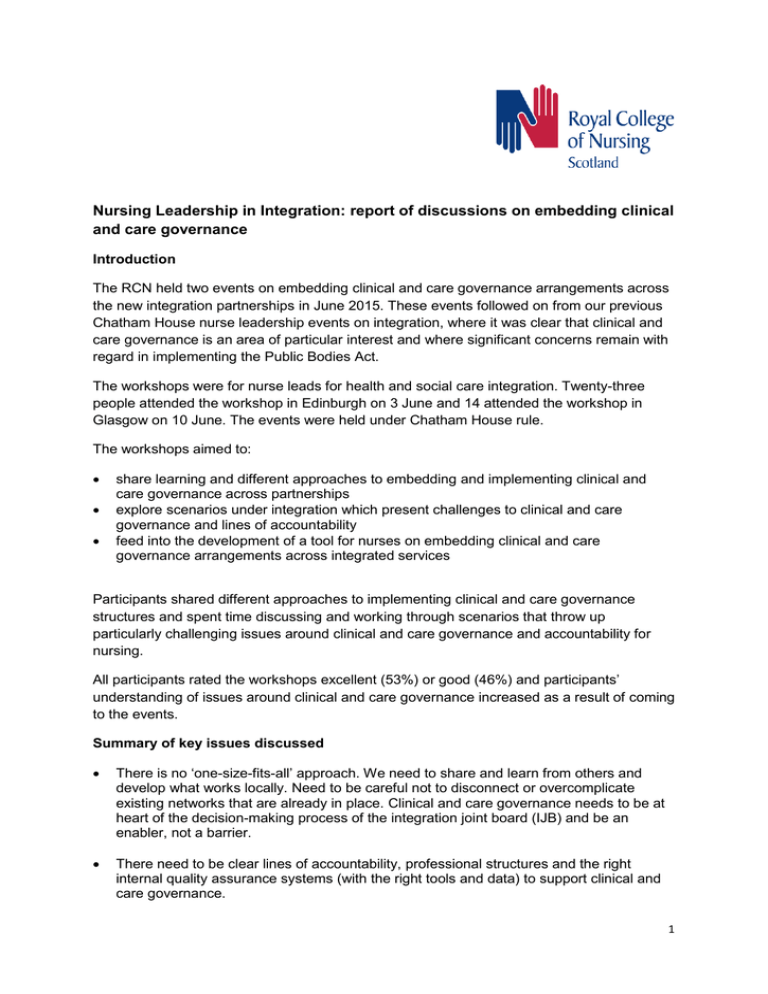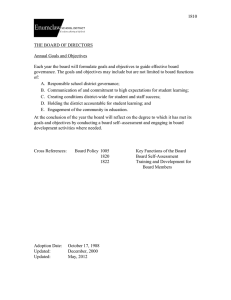Nursing Leadership in Integration: report of discussions on embedding clinical
advertisement

Nursing Leadership in Integration: report of discussions on embedding clinical and care governance Introduction The RCN held two events on embedding clinical and care governance arrangements across the new integration partnerships in June 2015. These events followed on from our previous Chatham House nurse leadership events on integration, where it was clear that clinical and care governance is an area of particular interest and where significant concerns remain with regard in implementing the Public Bodies Act. The workshops were for nurse leads for health and social care integration. Twenty-three people attended the workshop in Edinburgh on 3 June and 14 attended the workshop in Glasgow on 10 June. The events were held under Chatham House rule. The workshops aimed to: share learning and different approaches to embedding and implementing clinical and care governance across partnerships explore scenarios under integration which present challenges to clinical and care governance and lines of accountability feed into the development of a tool for nurses on embedding clinical and care governance arrangements across integrated services Participants shared different approaches to implementing clinical and care governance structures and spent time discussing and working through scenarios that throw up particularly challenging issues around clinical and care governance and accountability for nursing. All participants rated the workshops excellent (53%) or good (46%) and participants’ understanding of issues around clinical and care governance increased as a result of coming to the events. Summary of key issues discussed There is no ‘one-size-fits-all’ approach. We need to share and learn from others and develop what works locally. Need to be careful not to disconnect or overcomplicate existing networks that are already in place. Clinical and care governance needs to be at heart of the decision-making process of the integration joint board (IJB) and be an enabler, not a barrier. There need to be clear lines of accountability, professional structures and the right internal quality assurance systems (with the right tools and data) to support clinical and care governance. 1 Clarity and shared understanding of roles and responsibilities is important, for example around professional advisory roles and around the difference between leadership and. management. The nurse on the IJB needs to know where to access support. Nursing has to be better at articulating its roles, with clear boundaries and the ability to say no. Delegation is a particular issue. There needs to be co-ordination not duplication of groups, meetings and reporting structures. IJBs, their supporting committees and groups, and integrated teams need to think about what and why data is being collected, how it is being used and how to have buy-in from staff. There were concerns about sitting on too many groups and discussion about how nursing can identify where decisions are being made and where and how it is best to influence. Nursing needs to be proactive and acknowledge it has a ‘license to interfere and influence’. Having IT systems and processes that allow the sharing of information and patient records is vital. Not having this presents one of the biggest risks to integration. Matrix working and providing equity of services is important. There will be codependency across IJBs for some board wide service and responsibilities. Some nursing leads, for example for mental health services, have remits across several IJBs. Currently there is a disconnect between strategic and locality planning. There is also an issue of ensuring clinical governance of beds commissioned from other localities. There are different approaches, language and culture between health and social care governance that can be challenging. Need to foster a common approach, have mutual understanding of needs and demands and learn from each other. Having a shared focus on outcomes is an important enabler. There are also different approaches to external scrutiny between health and social care. The relative roles and responsibilities around scrutiny is not clear. For example, is the health board Chief Executive or the IJB Chief Officer responsible for implementing and reporting on recommendations from inspection reports. Health has explicit links with Scottish Government; this is less the case forlocal authorities. This raises questions around how things will be mandated across IJBs, such as money allocated to specific services. More complex care is being delivered in the community. However just because care is being delivered in the ‘right place’ does not mean you can automatically presume that the right skill set is in place to deliver it. Does the community have the right clinical decision-making capability and support in place? Need to ensure that budget considerations do not outweigh decisions around the quality of care when commissioning services, for example intermediate care services. Some specific areas that raised issues for clinical and care governance under integration included: o prison healthcare o child and adult protection o self-directed support o commissioning services such as intermediate care services within care homes o out-of-hours care and lone working, for example advanced nurse practitioners and nurses working unsupported in care homes 2 Next steps The detail of the discussion will help inform an RCN toolkit for nurses on embedding clinical and care governance across integrated services. This will be published by October 2015. Thanks We would like to thank our speakers at the workshops: Glynis Gordon from NHS Forth Valley, Derek Barron from North Ayrshire and Julie Murray from East Renfrewshire. There was very positive feedback from participants on how useful they found their presentations and discussion. Our thanks also go to the Scottish Government for funding this event. July 2015 3


